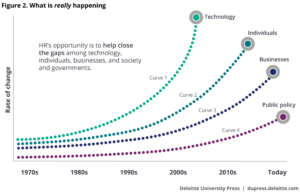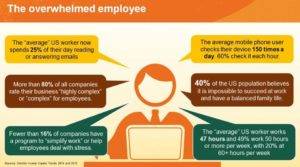Did you get the memo? We’re living in the future. But despite being in the middle of the 4th Industrial Revolution (or Industry 4.0), we’re not seeing the increase in productivity we’re used to seeing with the previous revolutions.
Labor productivity growth is at a historical low, in defiance of the increased fetishization of productivity, countless technological innovations we have seen in this current business cycle (beginning Q4 2007), vacation days decreasing, and hours growth outpacing its long-term historical trend.
What’s happening, argues Jeff Schwartz, Deloitte’s HR thought leader, is that while technology is advancing at an unprecedented rate and individuals are usually quick to adapt, “…business productivity is not driven by Moore’s Law.”
So what can organizations do to move the needle and close the gap between business productivity and technological advancement? Adapt with your workforce.
Schwartz and his colleagues at Deloitte Human Capital, among many others, believe HR has a unique role to play in helping leaders and organizations adapt to this rapid shift in technology — and to the expectations of a rapidly growing Millennial and Gen-Z workforce. Recently, Deloitte’s Innovation Tech Terminal teamed up with ZipRecruiter and WeFind in Tel Aviv to host their 3rd Meetup for its HR Tech Community featuring experts ranging from HR Tech startups, investors, and corporations to discuss 1) the future of work, 2) the biggest challenges that organizations will face, and 3) what they can do to reinvent themselves for this digital age.
Be flexible
At the meetup, Vered Raviv-Schwarz, COO of Fiverr — the world’s largest freelance services marketplace — discussed the huge shift in the way the world views & treats work that has major implications for organizations looking to hire top talent. “Almost 40% of the US workforce is freelancing. For employers, you’re competing not just with other companies, but with a way of life as well.” The “Freelancing in America: 2016” survey performed late last year seems to validate these comments, with 63% of freelancers doing it by choice, and with 50% saying that there is no amount of money that would get them to go back to a traditional job — and why would they when, according to the survey, a majority of freelancers that left a full-time job made more money within a year.
According to Vered, “You’re not just competing on compensation, but flexibility — you need to give [employees] the feeling that they can be intrapreneurs.” Following the leads of the Amazons and Googles of the world, organizations are embracing a risk-tolerant culture and encouraging experimentation in the workplace. Others, like WordPress (with 400 employees) and Buffer, are ditching the office completely, opting to go 100% remote with many finding that, in terms of employee retention, there’s no place like home.
Instead of trying to compete with the gig economy, companies can choose to embrace it. Working with freelancers would provide companies numerous benefits such as the flexibility of a fluid workforce that you can easily scale up or down for projects and a wider access to hyper-specialized talent. Routine process tasks and hierarchy are being phased out by automation as organizations are shifting towards being project-based networks of teams, so these off-balance sheet workers could eventually represent a sizeable chunk of the organization of the future.
Love thy employee
It’s going to take a lot more than flexible work policies to motivate this growing digital-first generation of workers. Companies will need to be more employee-centric and place as much emphasis on the employee experience as they do on the customer experience. This means, according to Schwartz, HR Tech will need to provide an end-to-end view of the entire employee experience, from recruitment to retirement, rather than just focusing on engagement and culture.
This includes reinventing how you measure and evaluate employee performance. Gone are the days of annual reviews and focusing on individual achievements. Enter continuous feedback loops and aligning rewards with an individual’s contribution to the team and the team’s contribution to overall business goals of the company.
Ronni Zehavi, CEO & Co-Founder of Hibob, an HR and employee benefits platform for SMBs that focuses on the end-to-end employee experience, argues that many HR platforms are B2B-oriented, with no focus on the “C” — “C” being the employee. With companies devoting up to 80% of their monthly expenses on people, “…they’re essentially your largest asset and resource for growth. To manage your #1 expense and resource, you need tech. It doesn’t make any sense that you pay for CRMs like Salesforce to manage your sales pipeline and marketing, but you neglect the people.”
Develop your talent
It’s no secret Millennials are notorious for job-hopping — 60% say they are open to new job opportunities with 21% having changed jobs in the past year (3x non-Millennials). With estimates having Millennials making up 75% of the total US workforce by 2025, organizations must move fast to retain them or risk being left behind.
Millennials and Gen-Z workers can expect to live for 100 years, meaning they’ll be working for 60-70 years. And, according to Schwartz, with the average worker staying at their job for ~4 years and the half-life of a learned skill being ~5 years, everyone will have one job — to constantly be learning. This represents an opportunity for organizations to increase retention and develop the younger, more agile and digital ready leaders of the future by providing training in the beginning of their employees’ careers and throughout.
PepsiCo is doing this by focusing on a framework of “Critical Experiences” — immersive experiences (like pioneering a new product) that force you to deal with ambiguity, take you out of your comfort zone, and help you develop new skills & knowledge. The idea is that you can draw from the insights and perspective these experiences give you no matter where you end up in your career.
Be attractive
Ranked as the 3rd most important challenge businesses face in Deloitte’s 2017 Global Human Capital Trends report, it’s apparent organizations are scrambling to catch up their Talent Acquisition efforts to the dramatic shift in jobs & skills needs that are brought on by rapid technological innovation. In the new age of talent acquisition, companies will have to move beyond traditional systems and adapt to emerging technologies, capabilities, and needs if they want to attract the best and brightest.
Building a digital employment brand is a necessity if you want to recruit top talent now. Companies like Industry, a professional network and hiring platform for the service and hospitality industry, are breathing digital life into an entire sector that otherwise uses rather archaic hiring methods like paper resumes and Craigslist ads — not ideal when the job turnover is 72%. For instance, Industry leverages video & photos for its users to build their brands, allowing restaurants to post a “Company Culture Video” on their hiring page and professionals to post short clips and pictures to highlight their creations and personalities.
Others are leveraging cognitive systems like IBM Watson by consolidating data from the employee lifecycle and social media to predict future performance of candidates, optimize recruitment marketing, and increase the speed of hiring.
Moving forward
Previously viewed as a compliance-only function, with 404 deals and $2.2 billion in funding in 2016 alone, according to CB Insights, and changes in human capital philosophy, HR has emerged as the strategic function in helping organizations navigate the 4th Industrial Revolution and the new expectations & increased competition that comes with it.











